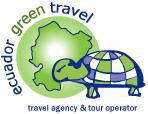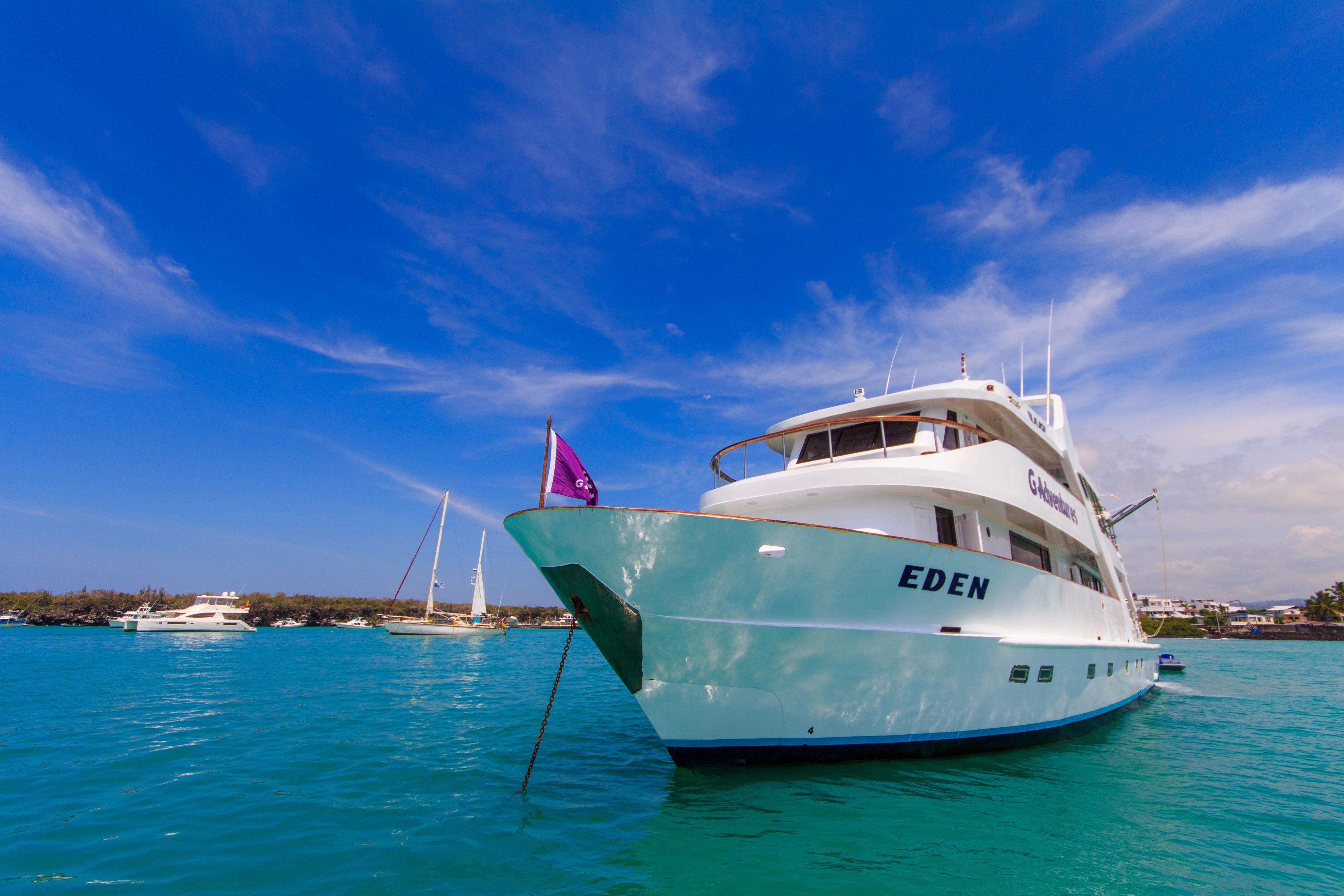DAY 1: THURSDAY
AM: Baltra Island Airport. Arrive at Baltra airport and transfer to the Galapagos Endemic Catamaran.
PM VISIT: BARTOLOMÉ/BARTHOLOMEW ISLAND.
Bartholomew is a small but scenic island, home to the iconic, pointy Pinnacle Rock. There are only two visitor areas on Bartholomew: a series of wooden steps leading to a scenic overlook and a small, sandy beach. There’s not a lot of wildlife on the way up the steps – look for lava lizards – but the view is spectacular. The small beach is one of the better snorkeling spots in the Galapagos, as there is a small penguin colony there and the penguins enjoy darting around snorkelers underwater. You can also see any number of fish and rays, and maybe even a shark or two if you’re lucky.

DAY 2: FRIDAY
AM VISIT: PUNTA CORMORANT/CORMORANT POINT, FLOREANA ISLAND.
Cormorant Point features two beaches and a flamingo lagoon, but oddly enough, no cormorants (which are found mostly in the western islands of Fernandina and Isabela). Cormorant Point is sort of like two sites in one: the landing site is a green sandy beach popular with sea lions, but a short walk takes you to the other side of the point and a gorgeous white sand beach. You can wade in up to your ankles, but don’t go any deeper: the waters of this beach are full of stingrays! On most days, you can see dozens of them just off the beach.

AM VISIT: CORONA DEL DIABLO/DEVIL’S CROWN, OFF OF FLOREANA ISLAND.
The Devil’s Crown is a jagged set of rocks in a roughly circular shape off of Floreana Island: they are the final remnants of an ancient volcanic crater mostly eroded over the ages. It’s a marvelous snorkeling spot: the deep water on one side is good for seeing large rays, sharks, and other spectacular large marine life, while the interior of the ‘crown’ is calm and often full of playful sea lions.

PM VISIT: BAHÍA POST OFFICE/POST OFFICE BAY, FLOREANA ISLAND.
Back in the day, whalers and other ships roamed the seas, often for years at a time. For the men who worked these ships, communication with home was very difficult and they would leave letters in certain places around the globe: one such drop-off was a barrel at what came to be known as “Post Office Bay.” The barrel is still there: leave your letter for a loved one! The site also features a nice sandy beach perfect for relaxing or snorkeling.

PM VISIT: MIRADOR DE LA BARONESA/THE BARONESS’ OVERLOOK, FLOREANA ISLAND.
From a sandy beach, a short trail leads to the Baroness’ overlook, where visitors will get a good view of the Floreana coastline. Ask your guide for the story of the “Baroness of the Galapagos.” It’s a murder mystery which is unsolved to this day! After a visit to the overlook, there will be the opportunity to take a panga ride along the coast or take out one of the sea kayaks.
DAY 3: SATURDAY
AM VISIT: SOMBRERO CHINO/CHINESE HAT, OFF SANTIAGO (JAMES) ISLAND.
Chinese Hat, named for its distinctive conical shape, is a visitor site memorable for geology and animal life. The island is known for lava tubes and pillow formations, meaning that it likely was formed underwater and later was pushed to the surface by geological forces. Besides being an informative case study in volcanic geology, Chinese Hat is home to sea lions, penguins, and Sally Lightfoot Crabs. The hike is followed by panga rides, snorkeling and kayaking.

PM VISIT: SEYMOUR NORTE/NORTH SEYMOUR ISLAND.
Another visitor favorite, North Seymour has something for everyone. The Frigate Birds and Blue-Footed Boobys nest right next to the rocky trail, allowing for spectacular photographs. The island is home to a booming population of Land Iguanas, often seen contentedly munching on cactus pads. There are usually dozens of sea lions near the landing site and along the beach. As if that’s not enough, the snorkeling is excellent!

DAY 4: SUNDAY
AM VISIT: MOSQUERA ISLET. MOSQUERA IS A SANDY,
sparsely vegetated sand bar known for sea lions, lava gulls, shorebirds, and Sally Lightfoot crabs. Lucky visitors might get to see a Yellow-crowned Heron as well! The visit features a guided walk around the islet and the chance to snorkel offshore.

PM VISIT: CERRO DRAGÓN/DRAGON HILL, SANTA CRUZ ISLAND.
Some say the rocky hill got its name because it’s shaped like a dragon, others say it’s because there are so many land iguanas along the trail. Either way, Dragon Hill is a fun hike along a dusty trail winding through cacti and Palo Santo trees. Look for birds, including flycatchers, warblers and flamingos, and pintail ducks in the salty lagoons. This visit is followed by the opportunity to snorkel offshore.
DAY 5: MONDAY
AM VISIT: BAHÍA DARWIN/DARWIN BAY, GENOVESA (TOWER) ISLAND.
The long-eroded remnants of a prehistoric volcanic crater, Genovesa Island has a distinctive crescent shape. A memorable visitor site on the bay leads through some mangroves and past many nesting birds including Red-footed and Nazca Boobys, Frigate Birds, gulls, and more. From February to June, the Frigate Birds inflate their bright red throat pouches. Look for stingrays trapped in tidal pools at low tide. Following the visit, our guests will have the opportunity to snorkel, kayak, or take a panga ride around the tranquil bay. Snorkelers sometimes see Hammerhead sharks!

PM VISIT: EL BARRANCO/PRINCE PHILIP’S STEPS, GENOVESA (TOWER) ISLAND.
Across Darwin Bay from the morning visitor site, Prince Philip’s Steps is a spectacular site for bird lovers. After a brief clamber up a rocky bluff, visitors emerge onto a plateau where they can see the elusive Short-eared Owl: this site is one of the only places in the Galapagos where these birds are commonly seen. Look for Red-footed and Nazca Boobys, storm petrels, and Tropic Birds. The visit is followed by the chance to do some more snorkeling or kayaking in the bay.
DAY 6: TUESDAY
AM VISIT: LOS GEMELOS/THE TWINS, SANTA CRUZ ISLAND.
The “twins” of the leafy highlands of Santa Cruz island are two sinkholes created long ago by underground lava tunnels which collapsed. A shady trail covers the short distance between the main road and the two sinkholes. Your guides will explain the special forest found in and around the sinkholes: it is home to many Scalesia pedunculate trees, endemic to Galapagos. The Twins visitor site is a good place to see finches, Vermilion Flycatchers, and mockingbirds.

PM: BALTRA ISLAND AIRPORT. AFTER OUR LAST VISIT
you will continue your journey to Baltra Airport escorted by our representatives.





























